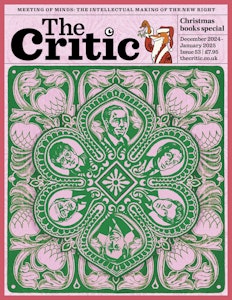This article is taken from the November 2024 issue of The Critic. To get the full magazine why not subscribe? Right now we’re offering five issues for just £10.
Fractional ownership has been around as long as the art trade has existed. A work of art would be purchased by a principal, and shares in that work (or works) would be owned by others: i.e. part-ownership, rather like owning a racehorse’s leg.
What has become a hot topic over the last decade is the sense that art can be tokenised and traded as fractions of a larger whole by non-specialist or retail investors.
Several companies, such as Maecenas, Feral Horses, Look Lateral and Masterworks, were part of this new generation of art investment/fractional ownership, building on the enthusiasm for transacting in cryptocurrencies. Feral Horses even sought investment from Dragons’ Den and was savaged.
Its mission, apparently, was to reshape “art investments, making it accessible to everybody and satisfying a thirst for flexible art enjoyment whilst supporting emerging artists”. They no longer operate.
The others — and they are by no means the only platforms — have evolved into pure investment vehicles. Most point to worthy aims as part of their company’s mission. Look Lateral, apparently “introduces increased liquidity, accessibility, transparency, and new opportunities to the market. For everyone”.
Maecenas describes itself as a “marketplace that allows anyone to purchase fractional interests in great works of art, using the ease and efficiency of blockchain technology” and “democratising access to Fine Art investment”.
All well and good, but what is democratising access to fine art investment, if not the physical work of art (which stays in a warehouse), actually good for?
So far, the largest player, Masterworks, has been dominating the market. Its website boasts of more than 60,000 investors. It claims its “mission is to make art investable”, and it wants to “transform the art market”.
As is so often said in the art world, it’s easy to buy but much harder to sell
Masterworks may not have transformed the market yet, but it certainly seems to be supporting it. Its data notes a wonderful rise in the value of post-war and contemporary art over the past decade or more.
However, when you become the largest buyer in the market, largely supporting the base of the market, what happens when you come to sell? Most of these new businesses talk warmly of buying art, but rarely of the difficulties of resale. As is so often said in the art world, it’s easy to buy but much harder to sell.
So far, Masterworks has been buying up works and selling shares in the asset, often with delayed payment terms, giving time for the Masterworks team to aggressively sell the shares to retail investors. In 2022 it had reportedly bought up $475m worth of art.
Almost all fractional investments of art vehicles refer to the task of democratising the fine art experience. Which reminded me of the extraordinary moment in the middle of the 17th century, when the Royal Collection was sold off by Cromwell at rock-bottom prices in order to pay the New Model Army. This apparently led to some of these great works now in Buckingham Palace and Windsor Castle being owned by ordinary men and women up and down the country, at least until Charles II returned and ordered as many paintings as he could back to Whitehall Palace.
Of course, with this type of fractional ownership, it is simply not possible to experience for oneself a part of an indivisible entity, and so the whole concept of access to art in this way is bunkum. It is financialisation (or securitisation) of individual artworks.
Most of these investment platforms promote themselves as daring and unique and venturing into a new world of ownership, profitability and alternative investment. Ben Clark, CEO of Mintus, points out “as is true across all “alternative” investments, in tougher economic climates, quality is integral to value and that will continue to be the case in the near future”.
Indeed, Pierre Valentin, one of the most experienced art world lawyers, remarks, “I would want to know that the team behind the offering has the right background and experience.” Wise words indeed.
Ultimately, the best investments will be made based on a deep understanding of the quality of art. Is this a good Picasso or an average Monet, and therefore what is it worth in the current market? Does the condition compromise the resale value? Is it a fake? How can we prove its history?
Fractional investment may provide convenient access to owning a work of art, just as it is possible to buy shares in an investment trust or a listed company (without the dividend), but where is the joy and the reward of owning that work of art? Will there actually be any profits? If the art market continues on its downward slide, fractional investors in art will need to be very patient.
Enjoying The Critic online? It’s even better in print
Try five issues of Britain’s most civilised magazine for £10

This post was originally published on this site be sure to check out more of their content





